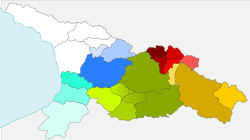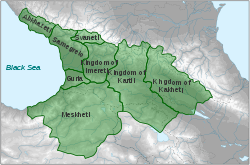Kakhetians
Kakhetians (Georgian: კახელები, kakhelebi) are an ethnographic subgroup of Georgians who speak Kakhetian dialect of Georgian language. Kakhetians are indigenous population of Kakheti, historical region in eastern Georgia, a fertile valley which produces much of the country's wine.[1] Today they are mainly followers of Georgian Orthodox Church.
 | |
| Total population | |
|---|---|
| c. 500.000 | |
| Regions with significant populations | |
| Languages | |
| Kakhetian dialect of Georgian language | |
| Religion | |
| † Georgian Orthodox Church. | |
| Related ethnic groups | |
| Ingiloy people and Iranian Georgians |
History
Kakheti was an independent principality from the end of the eighth century. It was incorporated into the united Georgian Kingdom at the beginning of the eleventh century, but for less than a decade. Only in the beginning of the twelfth century did Georgian King David the Builder (c.1089–1125) incorporate Kakheti into his Kingdom successfully.

After the disintegration of the Georgian Kingdom, Kakheti became an independent Kingdom in the 1460s. From the early 16th century till the early 19th century, Kakheti and its neighboring Kartli came under intermittent Iranian rule.
In 1616, Shah Abbas deported over a hundred thousand Kakhetians to Iran[2] and destroyed the region during his punitive campaign against Teimuraz I, his formerly most loyal subject.[3] During all these centuries the region was an integral part of Iran and it supplied many notable generals, administrators, women and many hundred of thousands of peasants for the Iranian overlords.
In 1762, the Kakhetian Kingdom was united with the neighboring Georgian Kingdom of Kartli into the Kingdom of Kartli-Kakheti under King Heraclius II. Following the Treaty of Georgievsk and the sack of Tbilisi by Agha Mohammad Khan, in 1801 the Kingdom of Kartli-Kakheti was annexed to the Russian Empire. Russian suzerainty over Kakheti and the rest of Georgia was recognized by Qajar Iran in the 1813 Treaty of Gulistan.[4]
In 1918–1921 Kakheti was part of the independent Democratic Republic of Georgia, in 1922–1936 part of the Transcaucasian SFSR and in 1936–1991 part of the Georgian SSR. Since the Georgian independence in 1991, Kakheti has been a region of the republic of Georgia. Telavi is still its capital.
See also
References
- CARLISLE, R. (1989). The Illustrated encyclopedia of mankind. New York, M. Cavendish.
- CORNELL, S. E. (2001). Autonomy and conflict: ethnoterritoriality and separatism in the South Caucasus - cases in Georgia. Uppsala, Dep. of Peace and Conflict Research, Uppsala Univ.
- Mikaberidze 2015, pp. 291, 536.
- Timothy C. Dowling Russia at War: From the Mongol Conquest to Afghanistan, Chechnya, and Beyond p 728 ABC-CLIO, 2 dec. 2014 ISBN 1598849484